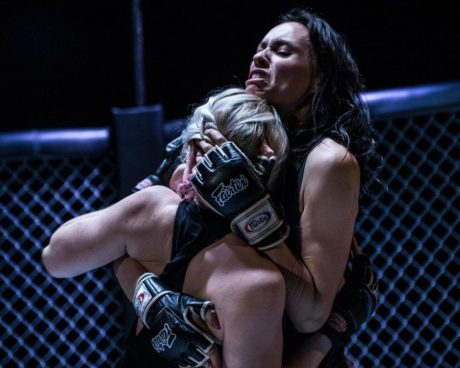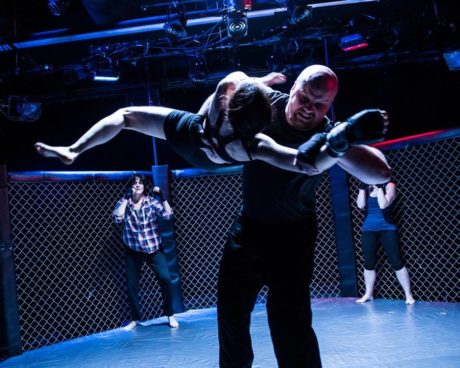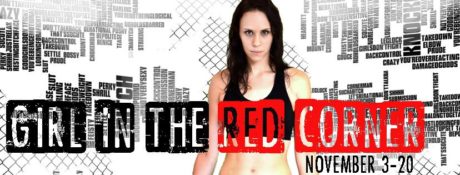Among the adages that keep women put down and passive is the one that goes, “Good girls don’t fight.” It’s a specious presumption that infects culture like an immobilizing toxin. It’s an addle-brained notion passed from mother to daughter like an incarcerating curse. And its legacy to sons is license and incentive to be the cockfighters and dominators who enforce it. Yet against all odds, some women learn to resist and renounce it—as in the gripping and graphic new play Girl in the Red Corner.

Stephen Spotwood’s impressive script for Girl in the Red Corner is the first to be produced by The Welders 2.0 (the second generation of the innovative playwrights’ collective). It opened last night at The Atlas Performing Arts Center in a knockout production directed by Amber Paige McGinnis.
Spotswood does for his main character Halo what Sly Stallone did for the movie role Rocky—create an arresting and irresistible character whose trajectory goes from down and out to triumph. Except that Halo becomes victorious through Mixed Martial Arts (MMA) instead of boxing. And Rocky being a dude had a leg up that Halo doesn’t.
Set Designer Deb Sivigny has turned the Lab Theatre II into a smashing black-and-gray fight cage. There’s a padded octagonal playing area surrounded on three upstage sides by chain-link fencing, which also wraps around the blackbox, in which we sit as if spectators to a match. The play’s disparate scenes are all performed here, at times in Lighting Designer Laura J. Eckelman’s unsparing glare, and whenever actors are not on stage, they sit ringside as if awaiting their next round. The stark authority of this ambiance, together with Sound Designer Chris Baine’s pounding tracks, generates an adrenaline rush that begins just pre-show and spikes again throughout.
Halo (compellingly played by Audrey Bertaux) recently ended a five-year marriage by dumping her layabout pothead of a husband. Now she’s quit her job two weeks short of unemployment benefits because her boss was sexually harassing her. With no prospects in sight, she scopes out a local MMA gym where she watches a trainer named Gina through the window. Finally Halo gets up the nerve to walk in and begin private lessons. The scenes of sparring and heart-to-hearting between Halo and Gina (in a terrific performance as tough cookie by Maggie Donnelly) are among the show’s punchiest and most poignant.
Halo lives at home with her mother Terry (a wonderfully versatile Lisa Hodsell, also appearing in two other roles), who is alcoholic and whose menial-job hours are being cut. Also under Terry’s money-scarce roof live Halo’s sister Brinn, a stay-at-home mom (played with touching conviction by Jennifer J. Hopkins), and Brinn’s husband Warren (an equally versatile Nicklas Aliff, appearing also as Gina’s boss at the gym).
One of the play’s many sharp-edged observations is the precise way Spotswood depicts the four women characters’ different relationships to fighting, as both metaphor and fact of self-assertion.
“Fighting doesn’t help,” Terry warns Halo, opting out of an employee-employer confrontation.
“I don’t want to fight,” says Brinn, dodging a sisterly confrontation.
Gina, on the other hand, has to fight. It’s how she got off drugs; she knows if she quits fighting, she’ll have a relapse.

And Halo knows in her gut that she needs to prove to herself that she can fight.
It’s Gina’s and Halo’s grit that drives the show. Bertaux’s portrayal of Halo begins with a timidity and tentativeness but by the end has an intensity that feels like invincibility. It’s a fascinating and thrilling arc. Among the standout scenes along it is the show-stopper when Donnelly’s steely Gina goads Halo into punching her mitt harder and harder by persistently hurling demeaning cliches at her (“Calm down.” Pow. “Don’t be so emotional.” Pow. “That time of the month?” Pow.)
Over the course of Girl in the Red Corner we are drawn deep into Halo’s inner emotional life as well as the vulnerable interiors of Gina, Brinn, Terry, and even Warren, who loses his job trying to help Halo get work. A female character not seen but who becomes a vivid presence in the play is Halo’s 13-year-old niece Ella. There’s a beautiful subplot in their emerging bond, a sense that Ella will learn her own rebuttal to “Good girls don’t fight” from her beloved aunt.
McGinnis’s direction is of the order of distinction that other directors will surely esteem. Her deft transitions between scenes are alone worth watching in admiration. Costume Designer Erik Teague not only outfits the fighters with verisimilitude; he pulls off the neat trick of keeping the actors’ doubling and tripling clear cut. And what Fight Director Clifford Williams III has done brilliantly is carry these characters’ storylines vividly through their every grapple, grimace, and groan.
Girl in the Red Corner is a triumph. For Halo. For The Welders. For women who fight the good fight. And for all to whom this matters, more than we may know.
Running Time: Approximately two hours, including one intermission.
Girl in the Red Corner plays through November 20, 2016 at The Welders performing at Atlas Performing Arts Center – 1333 H Street NE, in Washington, DC. For tickets, call the box office at (202) 399-7993 ext. 2, or purchase them online.
LINK:
“Magic Time! ‘In the Cage, She Has a Fighting Chance’: A Q&A With Stephen Spotswood About His New Play ‘Girl in the Red Corner’ at The Welders” by John Stoltenberg.
RATING:





